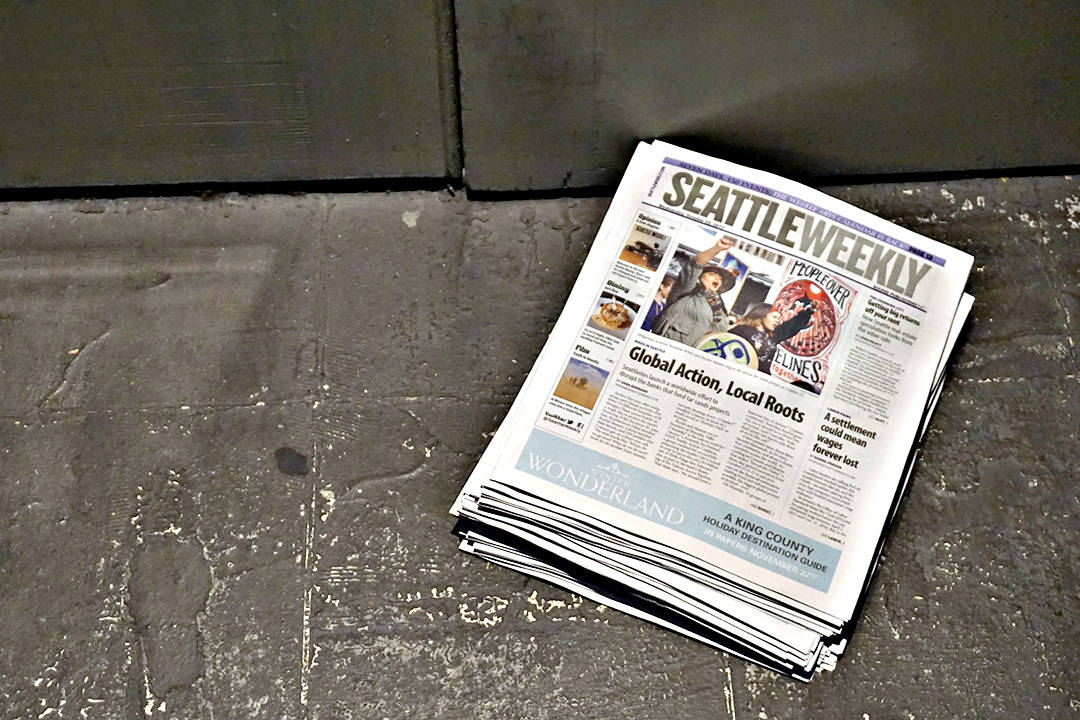Mere hours after sending the current issue of Seattle Weekly to press on Tuesday night, I sat alongside a few hundred other Seattleites at Town Hall, listening to a panel of local journalists of color during a forum titled #journalismsowhite.
I listened as they spoke of the dearth of diversity in the newsrooms of Seattle and beyond, of the need for our media organizations to have greater representation of the people and cultures that have been marginalized for far too long in our society and the pitfalls that result when the vast majority of a company’s staff consists of white men—which is still the case in many newsrooms, including Seattle Weekly’s. Bringing other perspectives into the newsroom is about more than meeting a diversity quota, said former Seattle Times columnist and Evergrey co-founder Monica Guzman. It is about accuracy, something that every person in that room would likely agree is the central tenant of good journalism.
Sitting there, taking notes, I was oblivious to the fact that the ink was just drying on a painful example of the inaccuracy that can result from a lack of representation. It wasn’t until the next morning, while giving the online version of this week’s cover story a look to make sure that it had published properly, that the phrase jumped out at me: “trail of tears.”
As anyone who has studied American history should know, the Trail of Tears has a very specific meaning. It is the name given to one of the most shameful moments in our country’s history, a chapter in the genocide of Native Americans when members of the Cherokee, Seminole, Chickasaw, Choctaw, and Creek tribes, among others, were driven from their homelands east of the Mississippi River and forced to resettle on reservations located west of the river. When we used it in this week’s feature, we weren’t referring to that tragedy. We were instead using it to describe a South Seattle community’s fight for transit access. It was, indeed, inaccurate, in addition to being wholly inappropriate and potentially hurtful.
And so I edited the phrase out and appended a notice of correction at the end of the story before most of our online readers could see the error. Unfortunately, I could do no such thing for the print version that fills our boxes across the city, and that now could serve as a painful reminder to our Native American readers of this history and our ignorance of it, while also perpetuating an erasure of their culture that has been going on for centuries and continues today.
Evidence of that larger narrative can be seen all around. Here at Seattle Weekly, we have written about the tribes on the Standing Rock Indian Reservation who are fighting for their sovereignty in the face of a corporate behemoth while demanding their rights to clean water—a fight that rightfully invites invocations of the Trail of Tears. Closer to home, we have witnessed the refusal of our government to recognize the Duwamish Tribe. It has been impossible to ignore the highest profile case of Native American negation as the NFL has continually refused to pressure it’s Washington, D.C. team to change its racist nickname. And even last night as I was watching the highlights of Game 2 of the World Series there it was again in another phrase that spoke to my fresh, heightened awareness: “The Cubs beat the Indians.”
Mistakes happen in the rush to get a story to print. Particularly in newsrooms that are guided by a white male perspective, a word that is used to describe a person or a work of art, say, might have a connotation that speaks to a painful history of racism and exclusion. Examples abound. It is reasonable in some instances to think that those responsible for the story were unaware of the connotations. An explanation for the oversight can be made, though it is still important that the reporters and editors recognize that their word choice might have been guided by unseen cultural forces, that our biases are not always conscious and that we must be better educated and vigilant in our usage of such loaded language. The use of “trail of tears,” though, offers no such relief. Its definition is definite. There is no connotation. It is what it is. And as the editor of this week’s cover feature, it was my responsibility to see that it had no business in that story. In not doing so, I have failed you, the writer of the story, and my publication. I apologize, and promise to do better—to be more accurate—in issues to come.







